What Animals Live On The African Savanna
The African Savanna is a large grassland habitat found across cardinal and southeastern Africa. In fact, the Savanna is so big that it touches 27 countries! The climate is warm and tropical, with heavy rains occurring in the summer season.
This unique habitat is domicile to legendary animals similar fast-paced cheetahs, long-necked giraffes, stripy zebras, enormous elephants, and animals you might take never heard of, similar the aardvark. There are some 45 mammal species and 500 bird species institute in the Savanna. Together they form a circuitous and interconnected customs, with every trophic level needed to maintain this fragile ecosystem.
The Savanna extends for miles into the horizon, an expansive plain of grass with irregularly occurring vegetation, such as trees like the acacia. There is picayune rainfall in this dry region of Africa. The Savanna, particularly areas like the Serengeti, have attracted tourists from around the world seeking to get shut to the near impressive Savanna animals of the plains for decades.
1. Grant's Gazelle
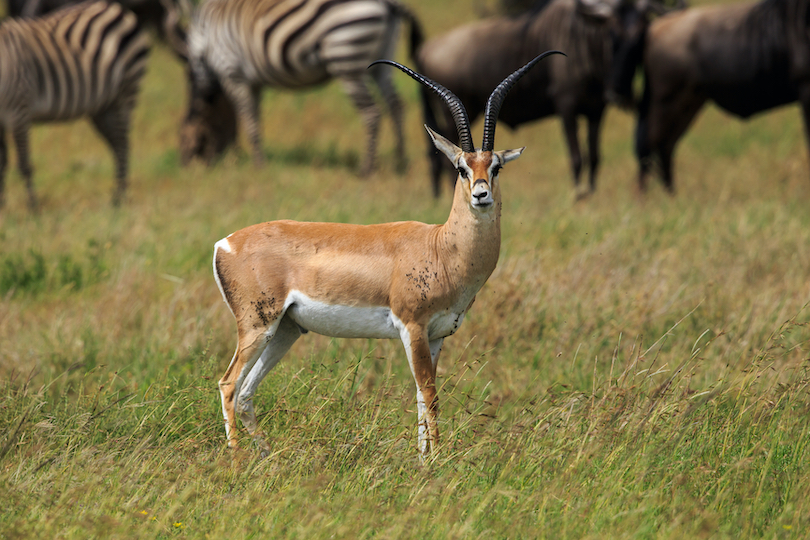 © dreamstime
© dreamstime
Grant's gazelles have a short and sleek glaze of fur that is reddish brown on their upper bodies and along the exterior of their legs, and white on their underside and rump. Their elegant, slender faces are decorated by two black and white lines that run from their antlers, over their eyes, down to their nostrils. Another blackness line decorates each side of the animal's rump.
They have long, ringed horns. Males have horns that accomplish lengths of 32 inches, whilst females' horns are about half the size. They forage for food, feeding mainly on scan, and migrate when food is deficient. Groups are herded by dominant males who mark out the herds' territory with urine and carrion.
2. Panthera leo
 © dreamstime
© dreamstime
Lions are found in various habitats in sub-Saharan Africa and are one of the well-nigh notorious animals of the Savanna. They are agile and fast, reaching top speeds of l miles per hour. Unlike other large cats, lions live in pocket-size groups, known as a pride, made upwardly of up to 30 individuals.
They are noon predators, meaning they hunt but aren't hunted, and can easily hunt downwardly and kill large prey like wildebeest, zebras, antelopes, and even pocket-size giraffes! Female lions do most of the hunting work. Lions take a loud and spectacular roar that can be heard up to iii miles abroad.
3. Blue Wildebeest
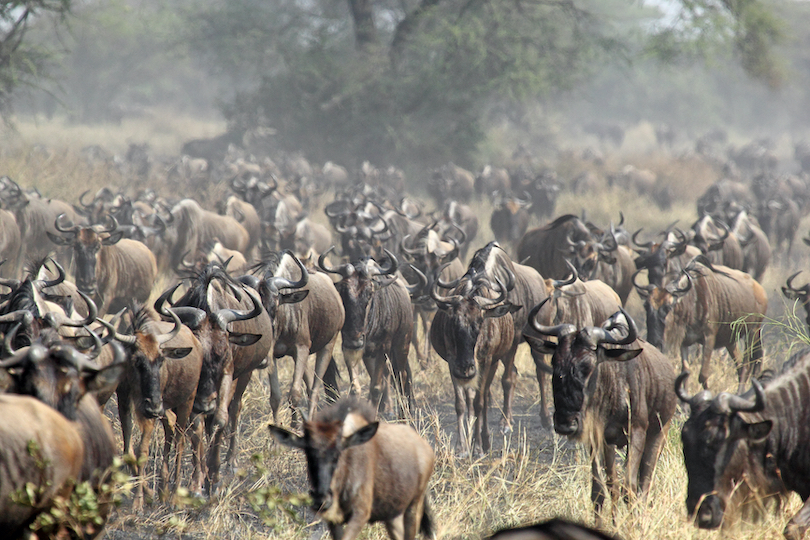 © dreamstime
© dreamstime
Blueish wildebeest are up to 8 anxiety long and iv.5 anxiety alpine at shoulder height. These 600-pound animals are grazers that feed on grasses forth their long migratory routes. They can run as fast every bit l miles per hour.
Wildebeests live in large herds of up to 500 individuals, though they tend to travel in groups made up of 10 to 100 females and their young. Male person wildebeests accept a loud calling audio that alerts the herd of a nearby predator. They are hunted by Savanna animals like lions and stampede as a fashion of self-defense.
4. African Bush Elephant
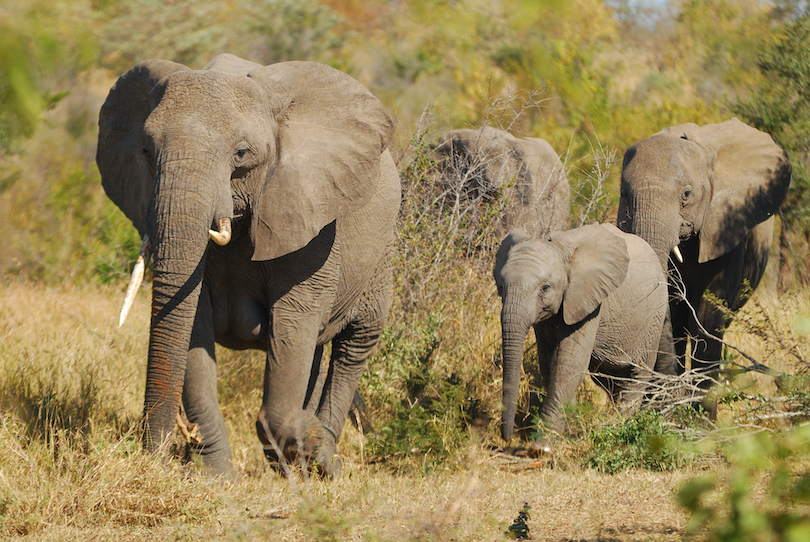 © dreamstime
© dreamstime
Elephants are some of the heaviest and largest animals on Earth. They are effectually 19–24 feet long, and 11 feet tall at shoulder meridian. Males can counterbalance up to a whopping xiii,000 pounds, whilst females counterbalance half of that. These impressive mammals can alive for up to 70 years.
They are easy to distinguish thank you to their size, long outward curved tusks, protruding trunks, and big ears. They spend their days foraging for leaves, bark, fruits, and grazing grasses off the Savanna flooring; they demand to eat around 350 pounds of vegetation daily to keep them going! Sadly, elephant populations have suffered declines for centuries due to poaching for ivory.
5. Black-backed Jackal
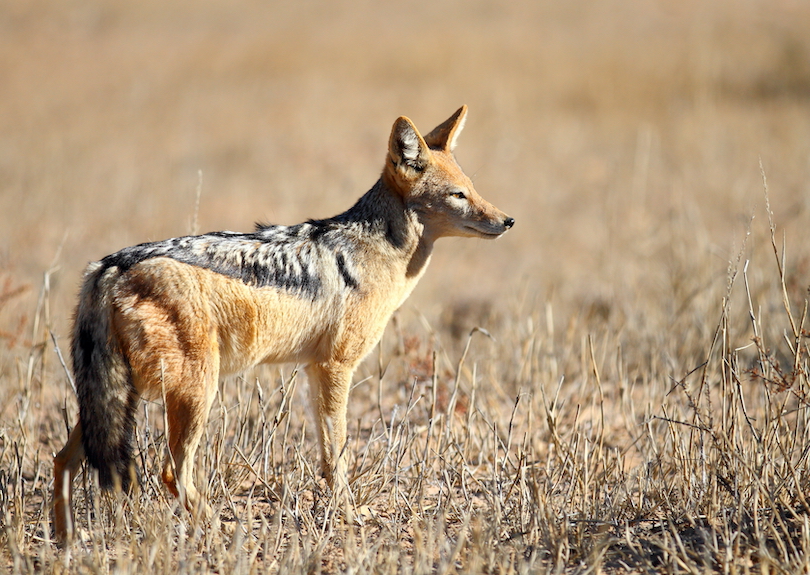 © dreamstime
© dreamstime
These cheeky animals have a black patch of fur that runs from their neck down to the end of their tail. They have white underbellies and otherwise reddish-brown torso fur. The blackness-backed jackal's pointy ears and long cage gives it a flim-flam-like appearance.
They take cracking senses of aroma and hearing that helps them track and hunt downward their prey. Opportunistic feeders, they're also happy to scavenge for their meals. In the wild, they chase during the mean solar day and during the nighttime, ears pricked and warning. Females requite birth to their pups in underground burrows.
six. African Leopard
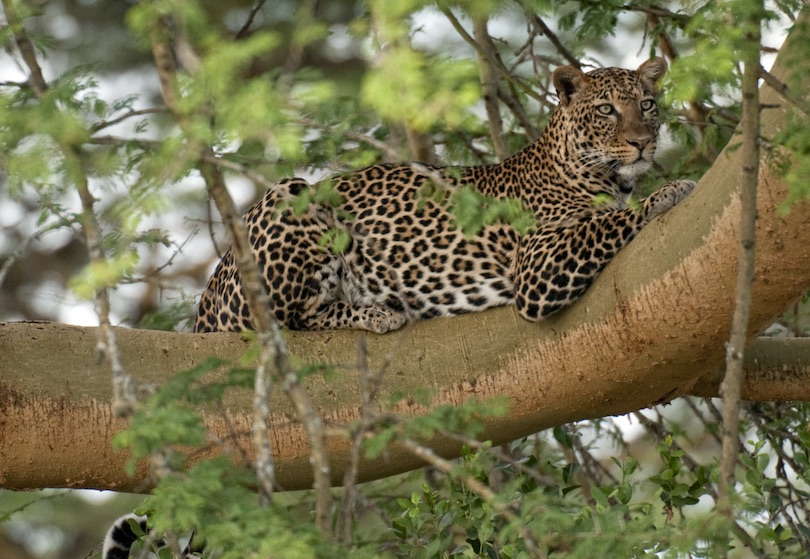 © dreamstime
© dreamstime
These handsome big cats have foam colored fur on their bellies that fades into a reddish-dark-brown along their upper bodies. They are easily identifiable thanks to the rosette shaped spots that cover their bodies. African leopards are highly athletic, able to run every bit fast every bit 58 miles per hr and leap up to 20 feet forrad in a single spring.
African leopards are excellent climbers and spend a lot of their time up amongst the tree branches on the look-out for prey to pounce on from in a higher place. In one case they've caught their repast, which can exist anything from an insect to a large wildebeest, they hibernate information technology from other elevation predators in between feeds.
7. Eland
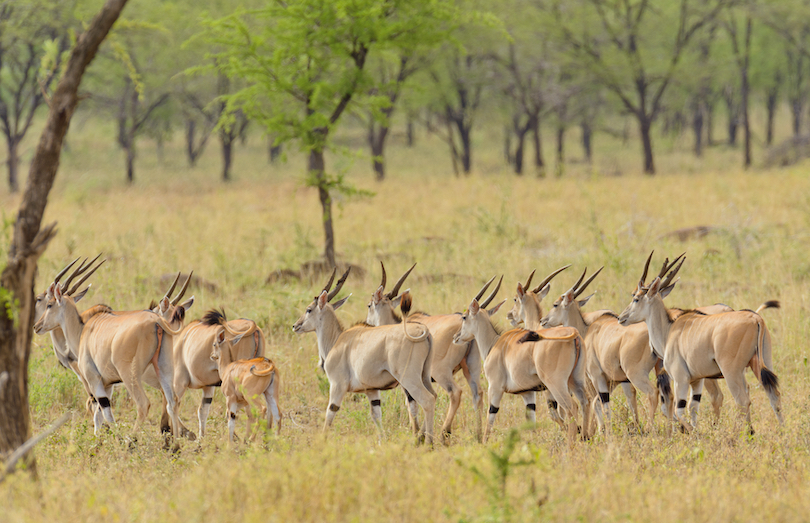 © dreamstime
© dreamstime
Elands are the largest antelopes on the planet. They are up to xi feet long and stand at some 8-human foot tall. These heavy mammals weigh almost a ton, but still manage to elevator their bodies off the basis and bound up to 4 feet into the air!
Their fur gets darker as they age, turning from a light brown to nearly black. They take elegantly twisted horns that grow skywards. Not surprisingly, elands are a popular repast amongst the larger predators of the Savanna, like lions, hyenas, and humans.
eight. Warthog
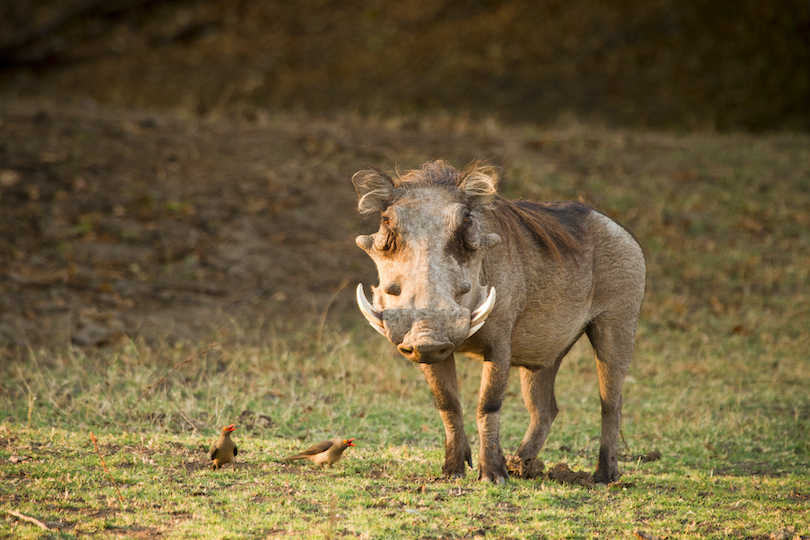 © dreamstime
© dreamstime
Warthogs look a lot similar wild boar. They have tough grey peel and slender tails. Two tusks, upwardly to x inches long, protrude from the animal'due south mouth. A peculiar feature of this animal is the tusk-similar protrusions that stretch the skin under their eyes outwards.
Though they aren't very large or athletic looking, warthogs tin can run at impressive speeds of upwards to 35 miles per hour. They kneel to feed on grasses, or chomp away at bulbs, roots, tubers, and even earthworms that they dig up with their tusks. A much-loved warthog in popular culture is Pumbaa from The Panthera leo Rex who taught the Hakuna Matata.
9. Caracal
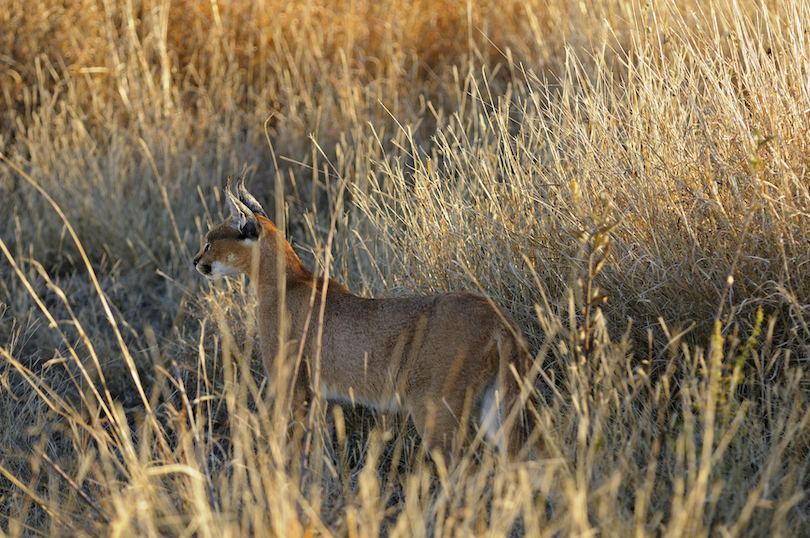 © dreamstime
© dreamstime
Caracals have a calorie-free, brownish-red coat of fur with a foam-colored underside. They are a medium sized species of wild cat that roam the African Savanna. They counterbalance somewhere between 25 and 40 pounds, and accept large pointy ears decorated with long, upwards facing, black hairs.
Their large ears aren't just decorative, they take 20 muscles in them that allow them to rotate, helping the caracal to listen out for nearby casualty. They predate on rodents, small mammals, mongoose, monkeys, birds, and hyrax.
ten. African Rock Python
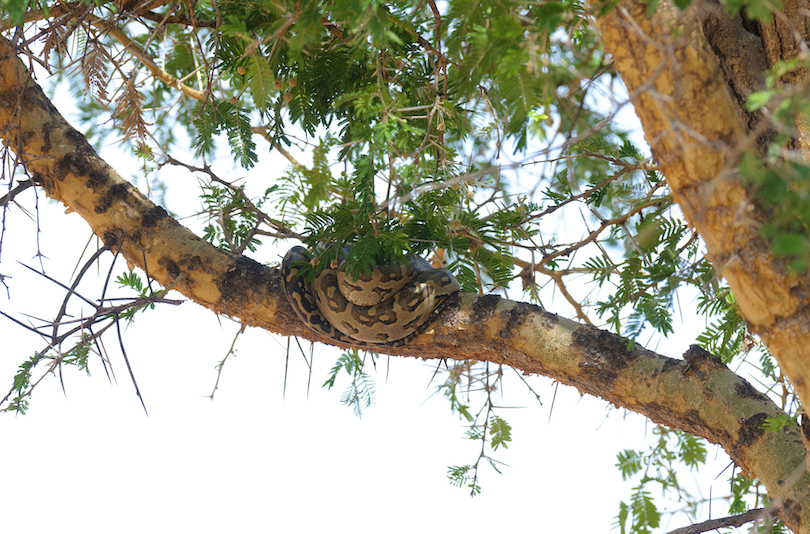 © dreamstime
© dreamstime
The African Rock Python is Africa's largest snake. Information technology reaches lengths of 20 feet; that's every bit long as a giraffe is alpine. Information technology is a non-venomous serpent species that kills its prey by constriction, tightening its grip around the poor animal's body on each outward jiff.
They can have down animals as big as crocodiles and warthogs, and in a few rare incidents have been reported to swallow immature children. As they are reptiles, they reproduce by laying eggs. Rock pythons can lay upward to 100 eggs at once, which they defend ferociously.
xi. African buffalo
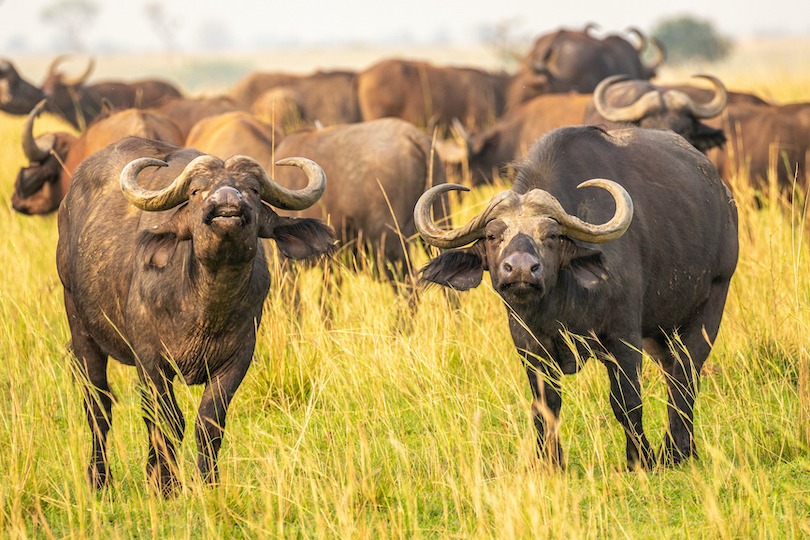 © dreamstime
© dreamstime
Buffalos are structurally very similar to large cows. There are four subspecies of buffalo in Africa, and large variations in size and coloration be beyond each. These heavy beasts are almost recognizable by their thick, curled horns that follow the line of their heads and so curl out to the side in a higher place their ears.
Larger buffalos reach heights of up to 5 feet and can weigh upwards to 1,840 pounds. They live in large migratory herds of a few hundred individuals. Buffalos have been known to besiege in their thousands in the Serengeti. Their large numbers assistance protect them from their many predators.
12. Meerkat
 © dreamstime
© dreamstime
These small mammals are merely 10–12 inches long and counterbalance a mere 2.2 pounds. Meerkats alive in small groups that gather and class larger communities. They are social animals that work together by distributing their tasks. Often a few meerkats will be allocated equally lookouts, whilst the residue forage for insects, birds, fruits, and lizards.
They raise their bodies upright, putting their weight on their back paws, to requite them a meliorate view of their surroundings. If they spot a predator, like a hawk or eagle, they allow out a loud, shrill telephone call. After a warning sign, anybody runs for cover.
13. Rhinoceros
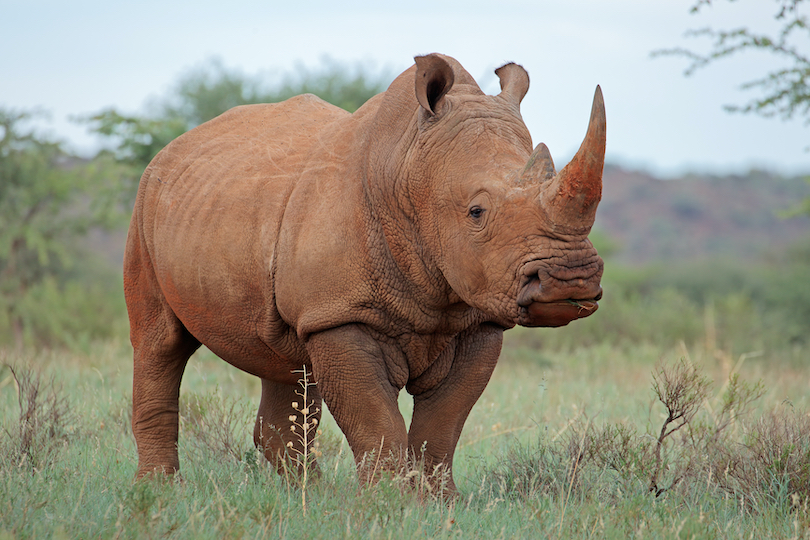 © dreamstime
© dreamstime
Rhinos are heavy mammals that weigh over ii,200 pounds (to as much as 4,400 pounds!). The white rhinoceros is found in the African Savanna, an ideal habitat for this large beast as there are h2o holes, mud wallows, grasses to graze on, and enough shade to hibernate from the hot sun.
White rhinos have ii horns; their forepart horn can reach lengths of 60 inches but tends to measure some 24 inches. These large animals eat around 120 pounds of food per twenty-four hours and accept a apartment snout and thick lips evolved to help them go closer to the basis floor to pick at grasses and vegetation.
14. Ostrich
 © dreamstime
© dreamstime
Ostriches are large, flightless birds. Their coloration is sexually dimorphic; males take a blackness body with white tail feathers, whilst females are covered in brown feathers. They have long, slender legs and a long, narrow neck. These large birds reach heights of 9 feet.
Ostriches are omnivores, and though 60% of their diet is plant-based, animals similar insects, snakes, lizards, and minor rodents are still on the card. They can run at speeds of up to 45 miles per hr and they live in packs of about 10 ostriches, with a ascendant female person and male in each.
15. Hartebeest
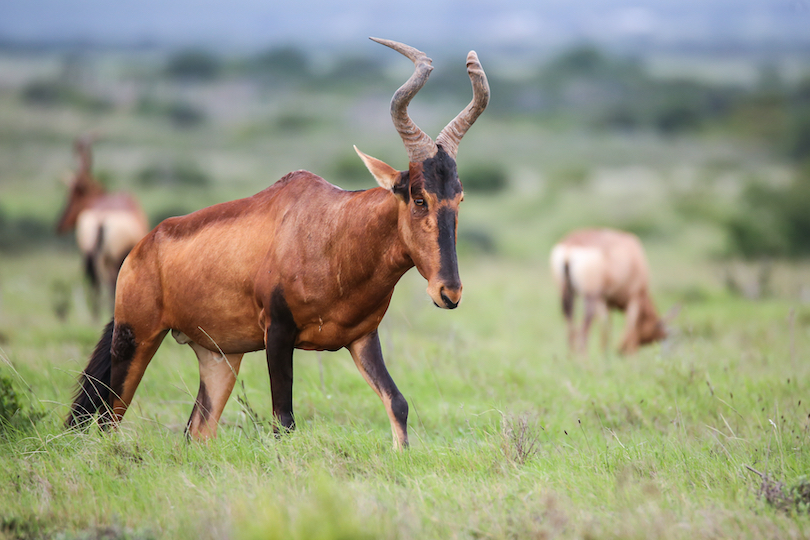 © dreamstime
© dreamstime
Another of the Savanna'southward antelope species, hartebeests have comically elongated faces. They have fawn colored fur, though some subspecies take black legs and tails. They tin run as fast as 45 miles per hour, almost every bit fast as a cheetah.
At their largest, they are some 8 anxiety long, weigh 440 pounds, and measure v anxiety at shoulder summit. Like other antelopes, they are elegant grazers that spend most of their fourth dimension munching on grass with their heads downwardly. But unlike other antelopes, they aren't migratory.
xvi. Giraffe
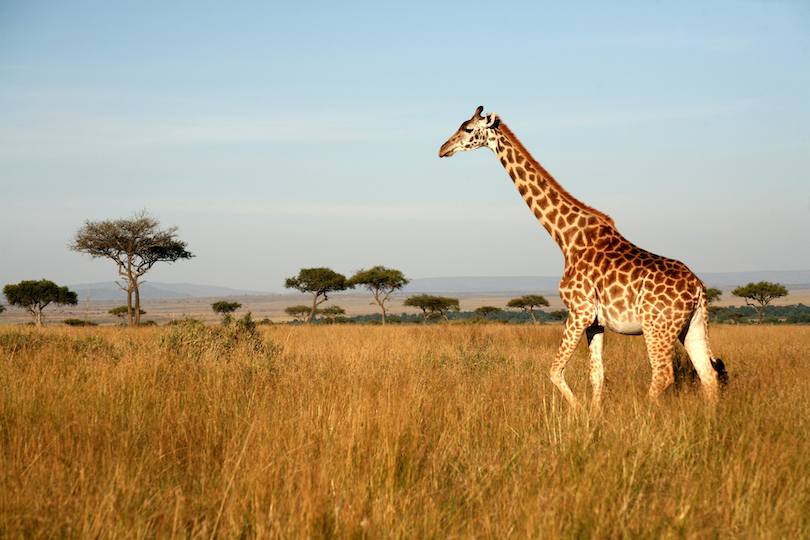 © dreamstime
© dreamstime
Giraffes are the tallest mammals on Globe, reaching heights of 20 anxiety. They are long and slender, and covered in patchy markings. Each giraffe has a totally unique ready of patches, similar each human has an individual fingerprint. Some other peculiar feature of this animal is its prehensile, blue tongue that is some xv–xviii inches long.
Giraffes are ruminants that take 4-chambered stomachs that help them digest their plant-based diet. They browse on leaves from bushes and trees; the leaves of an acacia tree are a particular favorite. To fuel their large bodies, they have to spend between 16–20 hours a twenty-four hour period grazing.
17. Impala
 © dreamstime
© dreamstime
These svelte and elegant mammals structurally resemble a gazelle. They are slender, with calorie-free cinnamon-brown fur and blackness type ears, a white chin and underbelly, and two black stripes on their rumps and ane along their tail. Males accept dazzling lyrate horns that are 18–36 inches long.
Impalas have evolved a clever feeding system that perfectly suits their environs; they feed on fresh grasses in the rainy flavor and switch to browse during the dry season. They live in large herds of upwards to 100 individuals, led by a male. These hypervigilant animals tin spring upward to x anxiety high and 33 feet beyond, an Olympic medal worthy high jump!
18. Aardvark
 © dreamstime
© dreamstime
These mysterious creatures have large, pointy ears, elongated heads, armadillo-like tails, and clawed feet. Their bodies are covered in a short, dark-brown fur that is darker along their limbs. These medium-sized mammals measure out some 43–53 inches in length and take 21–26 inch long tails. They are found south of the Sahara.
The discussion aardvark means 'earth pig' in the Afrikaans language of S Africa, and although these little mammals do accept some pig-similar qualities they are far from identical. Aardvarks spend the day hiding away from the oestrus in underground burrows and come out at night to forage for termites.
19. Spotted Hyena
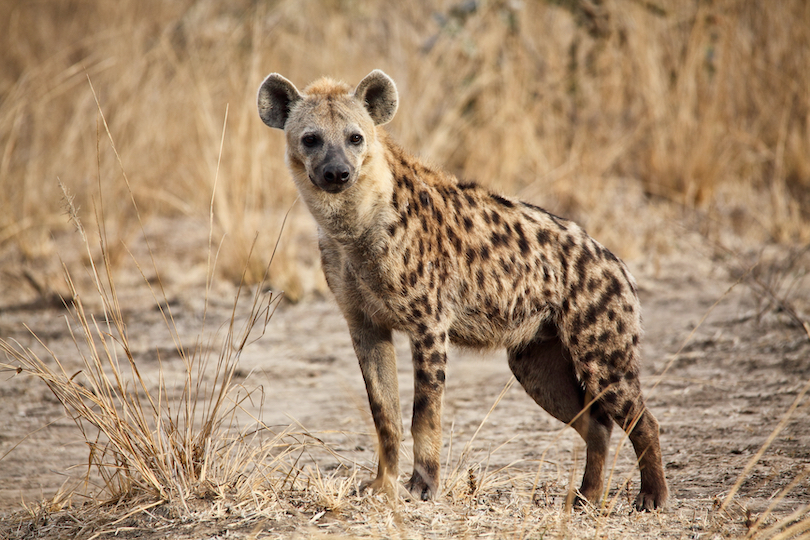 © dreamstime
© dreamstime
Hyenas stay together in groups known as clans. Spotted hyenas are the largest of all three hyena species; they are some 34–59 inches long. These well-known mammals look like spotted dogs simply are actually closer related to cats. They are famous for the curious laugh-similar sounds they brand.
We tend to think of hyenas as only scavengers, that spend their time feeding on the carcasses and scraps left backside past more skilled hunters. Whilst these opportunistic feeders volition happily scavenge for food, they are also skilled hunters themselves that work in groups and can accept down grazers as large every bit a wildebeest.
xx. White-Backed Vulture
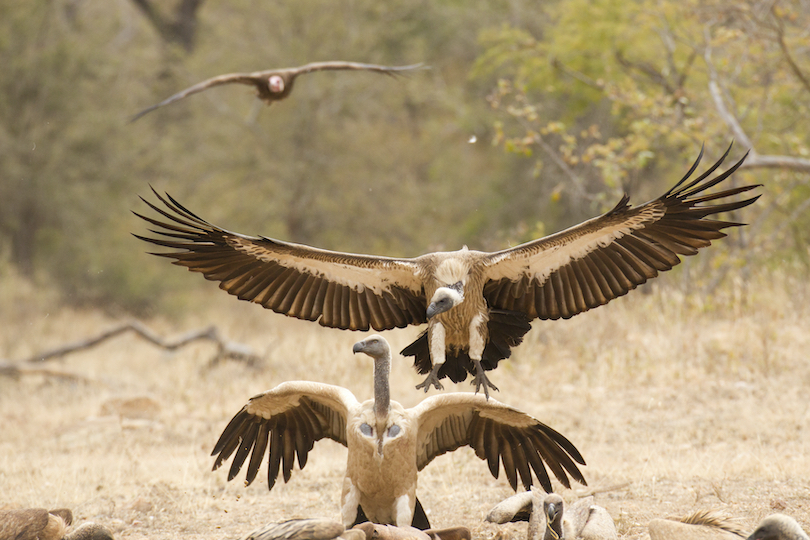 © dreamstime
© dreamstime
White-backed vultures have brownish plume on most of their body, pale underwings, a white feathered cervix, and a telling patch of white feathers on their rump that can only be seen when the bird is in flight. They are Africa's most common vulture merely are suffering declines in population numbers.
These large birds have a wingspan of upwards to vii.five feet and glide upwards above on the lookout for abased carcasses to feed on. They prefer more than open and wooded areas of the Savanna, where they gather on tree branches in loose breeding groups.
21. Plains Zebra
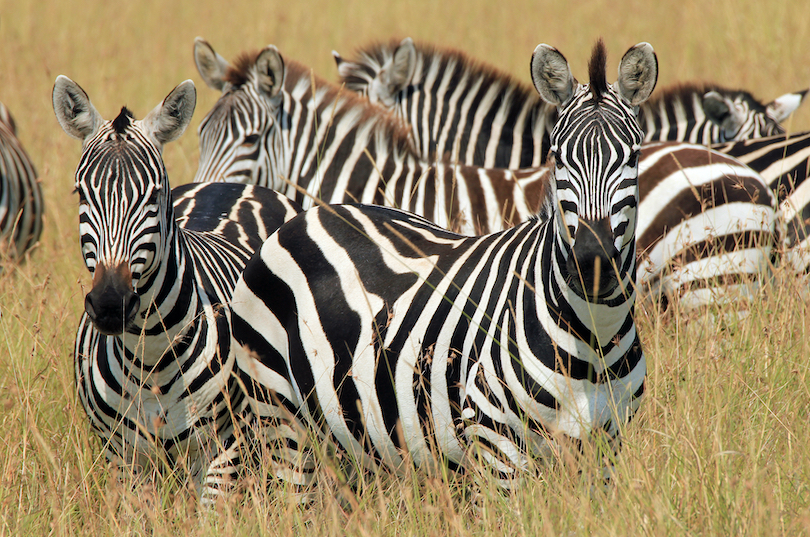 © dreamstime
© dreamstime
Are they white with blackness stripes or black with white stripes? Some questions virtually one of the Savanna'south most pop animals, the plains zebra, have puzzled humans for centuries. These black-and-white striped animals are ungulates with long tails, a short, upright mane, and a long face with a black patch around the oral fissure and nostrils.
They stand up at some 4.five feet tall and weigh a surprising 550–700 pounds. These eye-catching herbivores stay in large herds and are always warning and on the lookout for their many predators, similar cheetahs and lions. Zebras have long migration routes and migrate up to 1800 miles in search of fresh grass to feed on.
22. African Pygmy Falcon
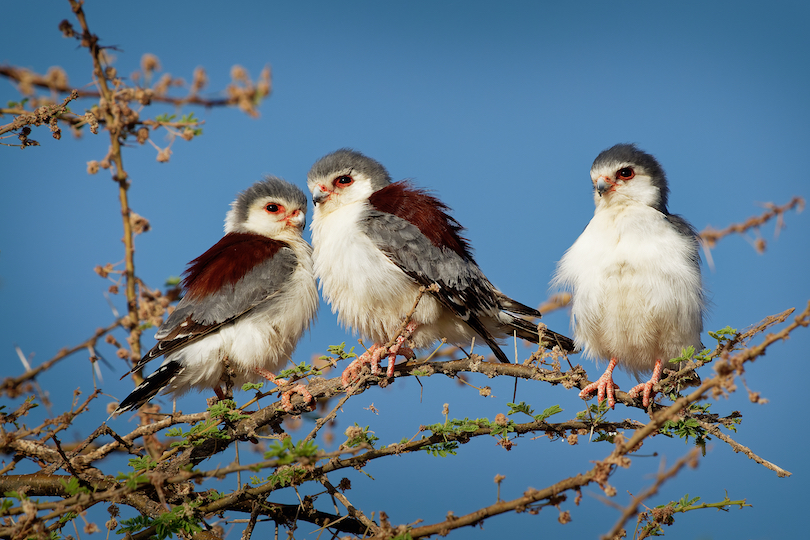 © dreamstime
© dreamstime
This cute little bird is Africa's smallest raptor species. Adults are almost equally long as a pen and have a wingspan of just fourteen inches! They live in communal weaver bird nests that hang off tree branches and accommodate a group of pygmy falcons and their weaver neighbors.
But they aren't squatters, they defend the nests from snakes and other egg-snatching reptiles, creating a symbiotic human relationship betwixt them and the weavers. Despite its size, the African pygmy falcon is an avid hunter that tin can dive downwards and effortlessly catch insects, small rodents, lizards, and birds.
23. Chetah
 © dreamstime
© dreamstime
The African Savanna is domicile to the fastest creature on World, the cheetah. Cheetahs tin can reach running speeds of upwards to 80 miles per hour, leaving their casualty with lilliputian take chances of escaping. They chase antelopes, gazelles, sable, and birds.
Cheetahs are lone like almost large cats and can live for upward to 12 years in the wild. Their low-cal brown fur is covered in small, black spots. This unique fur pattern makes this wild cat easily recognizable in the wild.
Source: https://wildlifetrip.org/africa-savanna-animals/
Posted by: steinhoffcoth1963.blogspot.com

0 Response to "What Animals Live On The African Savanna"
Post a Comment